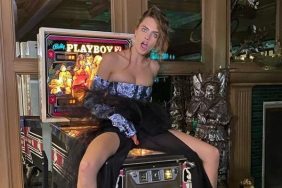
Pinball is iconic. Invoking visions of pizza parlors, old arcades with ratty carpets, and truck stops, they hearken from a time when the world was slower paced and people didn’t mind taking a break from their day to spend a few quarters for a chance at the high-score. Unfortunately, most of the icons of pinball have left the industry: Williams, Bally, Midway, Sega, and all the other big names have left the pinball business and are a shadow of their former selves. However, from the ashes from those iconic companies, Stern Pinball arose.

Making a Table
It’s a forward-thinking company, which is obvious from just looking at their extensive work history. When Stern beings to develop a new table, it prefers to go with licensed titles almost exclusively. Dankberg explained the reasoning behind this decision: “We use licenses that already have recognition behind them. If it’s popular throughout the world, that’s why we choose what we do.” He went on to cite Stern’s successes with tables like Metallica, AC/DC, Ford Mustang, and The Avengers, all of which have seen an admirable amount of success. By making the pinball machine an extension of an existing brand it offers a base idea to design off of, and makes it more likely that consumers will play. Stern works with actors, musicians, and technical personnel to ensure that their products translate the licensed property to the pinball world in the best way possible.

It’s clear an abundance of love goes into getting these pinball machines out into the world. Once the theme of the table is chosen, the designers begin to work their magic. Stern employs four different design teams and each one of them takes their own approach to design. Steve Ritchie, designer on the iconic Terminator 2: Judgement Day (1991) pinball machine by Williams, typically designs the grandest, most feature packed pinball table possible, then begins to see what can be taken away while still leaving the machine exciting and fun to play. John Borg, who was on the team that designed the Star Wars (1992) table from Data East, builds from the ground up. The unique approaches from each designer, along with their experience in the industry is a big part of what helps Stern continue to be the largest manufacturer in the industry, and provide fun and fresh boards at a rate far surpassing the competition.
Stern employs four different design teams and each one of them takes their own approach to design.
Once the tables are designed, they are typically split into sub-models. The pro edition is the base model, featuring simpler gameplay and lacking some of the artwork of the other models, these tables are also used for competitive play as they allow a more uninterrupted experience. Premium tables usually have uniquely casted pieces, such as the skull girl head from Stern’s The Walking Dead board and feature mirrored backlights and additional extra features. The limited edition models usually feature everything from the premium model and also feature some unique artwork and are hand-signed by the designer and numbered.

For those without an arcade near them or the multiple thousands of dollars to own a table of their own, Stern has partnered with Farlight Studios to digitize a number of their boards. Ripley’s Believe It or Not!, Flight 2000, HighRoller Casino, Phantom of the Opera, and Harley-Davidson tables are all available via Farlight’s Pinball Arcade. Each of the digitized machines are more than mere visual facsimile.
Farlight works with each board manufacturer to make sure that their virtual boards are complete replicas, down to every ramp, flipper, and art piece. Once the table is digitized, it is programmed into Farlight’s custom emulator, which uses the actual programming from the physical table to render an experience as close to being in front of the actual machine as possible. Stern hopes to continue to work with Fanlight on bringing tables to consoles, PC, and mobile, and digitize some of their more complicated multi-tiered machines in the future.

“Virtual tables do help recreations of older games. For instance, we had Ripley’s Believe It or Not, Roller Coaster Tycoon, and more. When we did the Ripley’s Believe It or Not table, the used value of the real one was going up because people would go out and buy it. Digital pinball is a great educational tool and a great marketing tool, we’ve found.”
However, despite the success of past digital tables, Stern has no current plans to create a digital-only table: “Maybe down the road,” Dankberg laughed during our chat. “In reality, we’re a full time manufacturer and very proud to be in the US, employing thousands of people. The core of our business is the physical table, but we’re starting to branch out a bit by digitizing our tables. It could be something we try in the future.”
“Digital pinball is a great educational tool and a great marketing tool.”
After a lengthy conversation looking back and discussing the standards and practices of the company’s past, what’s coming for the future? Dankberg gushes about the possibilities of the future: “We’d love to do a Jaws table. Cult classics would make for some cool pinball tables, but they’re difficult too, like Scarface, The Good, The Bad, and The Ugly. We love working with big current franchises, but we’d love a chance to try our hand at those too.”
Stern Pinball continually commits itself to continuing to manufacture and distribute an American icon, with the previously stated thousands of employees working full-time to design and manufacture pinball machines. Their new models and reproductions continuously sell out, with pinball aficionados and new fans drawn by the experience of the digital tables clamoring to get their hands on Stern’s quality machines. Although pinball doesn’t draw the mammoth amounts of players it once did, it is far from dead. As long as Stern Pinball is around, it has the support and dedication it needs to ensure a bright future.







